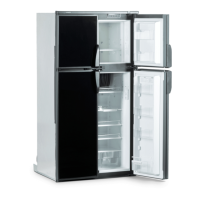- 15 -
DEFROSTING
1. Shut off the refrigerator by pressing the main
power ON/OFF button (OFF position).
2. Empty the refrigerator.
3. Leave the cabinet and freezer doors open and
make sure the drip tray is in place under the
nned evaporator.
Defrosting time can be reduced by lling ice trays
with hot water and placing them in the freezer com-
partment.
PRODUCT CARE
CLEANING
Always keep the refrigerator clean. Cleaning the refrig-
erator is usually done after it is defrosted or put into stor-
age. Use a lukewarm, weak soda solution to clean the
interior liner of the refrigerator. Use warm water only to
clean the nned evaporator, gasket, and shelves. Do not
spray liquids near electrical outlets, connections, or the
refrigerator components.
To keep the refrigerator operating efciently, periodic in-
spection and cleaning of several components once a year
is recommended:
• Check the lower vent, upper vent and area between
these openings for any obstructions such as bird/insect
nests, spider webs, etc.
• Make sure the refrigerator area is free from combustible
material, gasoline and other ammable vapors or liquids.
STORAGE PROCEDURE/WINTERIZ-
ING THE REFRIGERATOR
RM1350IM, RM1350MIM, RM1350WIM & RM1350WID
The refrigerator is equipped with a heater tape wrapped
around the water solenoid valve and outlet water tube.
During cold weather operation below 32°F/0°C the au-
tomatic temperature switch will turn the heater tape on
automatically.
If the RV will not be in use for an extended period of time
or put into storage:
• Drain the RV water system.
FIRE AND INHALATION HAZARD. Do not use
a knife, ice pick, or any other sharp tool to
remove frost from the freezer compartment.
Failure to obey this warning could cause a
leak in the ammonia cooling system which
could lead to a re hazard resulting in death
or serious injury.
An ammonia leak also poses an inhalation
hazard, and could cause chemical burns to
the skin and eyes. Exposure to a high con-
centration of ammonia could result in death
or serious injury.
4. When all the frost has melted, dry the interior with
a clean cloth and turn the refrigerator back on.
5. Set the thermostat to the coldest setting for a
few hours. Then, reset the thermostat to the
desired setting, usually at mid setting. Replace
food after refrigerator has reached appropriate
cool temperature.
Do not use a hot air blower to remove frost
from the freezer compartment. Permanent
damage could result from warping the metal
or plastic parts.
• Disconnect the water lines from the inlet and outlet sides
of the water valve. Drain the lines into a cup and allow
the lines to dry.
• The ice maker and water reservoir should be drained
and dried. Note that this procedure must be performed
by a qualied service technician.
• Using a lukewarm soda solution, clean the interior
liner of the refrigerator. Clean the finned evaporator
and shelves. Use warm water only and never strong
chemicals or abrasives since these can damage the
protective surfaces.
• Place doors in the airing position.
Do not use strong chemicals or abrasives to
clean these parts, as the protective surfaces
will be damaged.
• If accessible, clean the coils on the back of the refrigera-
tor. Use a soft bristled brush to dust off the coils.
FIRE OR EXPLOSION HAZARD. Do not store
or use gasoline, oil or gasoline soaked rags,
or other ammable vapors and liquids in the
service area behind the refrigerator or in the
vicinity of this or any other gas appliance.
Failure to obey this warning could cause a
re or an explosion resulting in death or seri-
ous injury.

